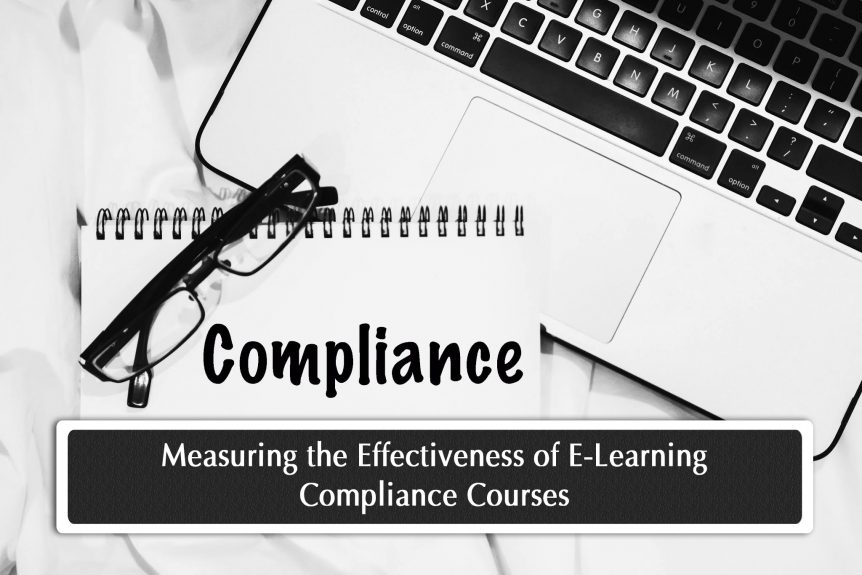Measuring the Effectiveness of E-Learning Compliance Courses
Creating and implementing compliance training should not be an exercise of going through the motions so you can tick boxes in a file somewhere. Instead, it’s important to ensure your compliance training is effective and that you are getting a return on investment.
This requires not just training your employees on compliance topics, but also following through on that training to ensure it is effective.
For many compliance topics and issues, e-learning is the best method of training delivery. The below points will help you measure the effectiveness of your e-learning compliance courses. However, you can apply many of the points to any type of training, i.e. not just e-learning courses.
Conduct a Risk Assessment on Compliance Training in Your Organisation
Not all compliance issues and topics will carry the same weight. For some, a breach of a law or regulation could be business critical at worst and seriously damaging to your reputation at best. Others are less important, however.
Therefore, you must allocate more resources to compliance issues that present your business with the greatest amount of risk. Conducting a risk assessment of compliance training in your business will help identify those areas that are lacking and that need brought up to a better standard.
For example, you may have an all-singing-all-dancing e-learning compliance training course on a topic that is low-risk but a low-quality and poorly designed training course on a topic that is high-risk. In this situation, you will need to invest in an upgrade to the course on the higher risk topic.
Conduct an Evaluation of Course Content
Another effective step in measuring the effectiveness of e-learning compliance courses is to evaluate the content. Is the content up to date with current regulations, business policies, business procedures, and best practices? If not, you should update the course.
Analyse the Implementation of Your Training
Put simply, is compliance training available and relevant for all employees who need it. For example, do you have compliance training applicable to employees in one jurisdiction but not in another because the laws are different or because employees in the other jurisdiction speak a different language.
Another gap you might find is where the training is classroom based. With e-learning, you can distribute a course quickly and easily. With classroom-based training, however, trainers might not be available, the quality of training can be inconsistent, etc.
Analyse Course Completion Rates
Another effective measure is to look at how many people complete e-learning compliance training courses. If there are significant drop-offs (i.e. people who start but don’t finish), you will need to investigate.
Check Knowledge Retention Rates
Retention rates are important for any type of training. Good knowledge retention rates confirm that learners grasped the topic instead of just getting to the end of the course. Poor knowledge retention rates can occur for a number of reasons, but it’s important you are aware so you can take action.
Three ways you can check knowledge retention rates are:
- Add a quiz immediately after the content on your e-learning course, ensuring the learner’s score is recorded and reported back to you either individually or aggregated
- Conduct a follow-up quiz to be completed by learners a month or two after they go through the e-learning course
- Implement refresher training with a quiz in 12 months’ time
Ask for Learner Feedback
Asking for learner feedback on the effectiveness of e-learning compliance courses is also helpful. The key to this process is to look for patterns, i.e. if lots of learners are saying a similar thing about the compliance training, you should investigate further and potentially make changes.
Get Manager Feedback
The managers in your organisation are often closer to what is happening at ground level in your business than senior executives or those responsible for creating and implementing compliance training.
In addition, managers are often the first point of contact when an employee wants to raise a concern or a complaint.
Therefore, managers are in a unique position to give you information on issues, gaps, and areas for improvement.
Observe Behavioural Changes
You can often measure the effectiveness of e-learning compliance courses by observing the behaviour of staff. After all, a lot of compliance training is about changing behaviour.
For example, you or a manager in a department might report that employees are more proactive in wearing PPE (personal protective equipment) after completing a health and safety training module.
Analyse Changes in Key Metrics
You will also get an understanding of the effectiveness of your compliance training by checking key metrics in your organisation. Examples include:
- Reduction in health and safety incident rates
- Reduction in complaints of harassment or bullying
- Improved employee satisfaction rates
- Increased reports to whistleblowing hotlines/email addresses
Mock Audits
The final tip for measuring the effectiveness of compliance training in your organisation is to bring in a third-party to conduct an audit. Its brief should be to identify problem areas and gaps in employee knowledge in relation to compliance.
As per the first point above, these issues should be risk assessed so you can prioritise and address them.
After all, it’s better that you identify and then fix issues in a mock audit situation rather than during the real thing.
Back to Basics
Compliance in your organisation isn’t about putting staff through training. Instead, it’s about making sure your business operates according to laws and regulations by ensuring your employees understand rules, policies, and responsibilities.
Measuring the effectiveness of your e-learning compliance courses will help you achieve this.

